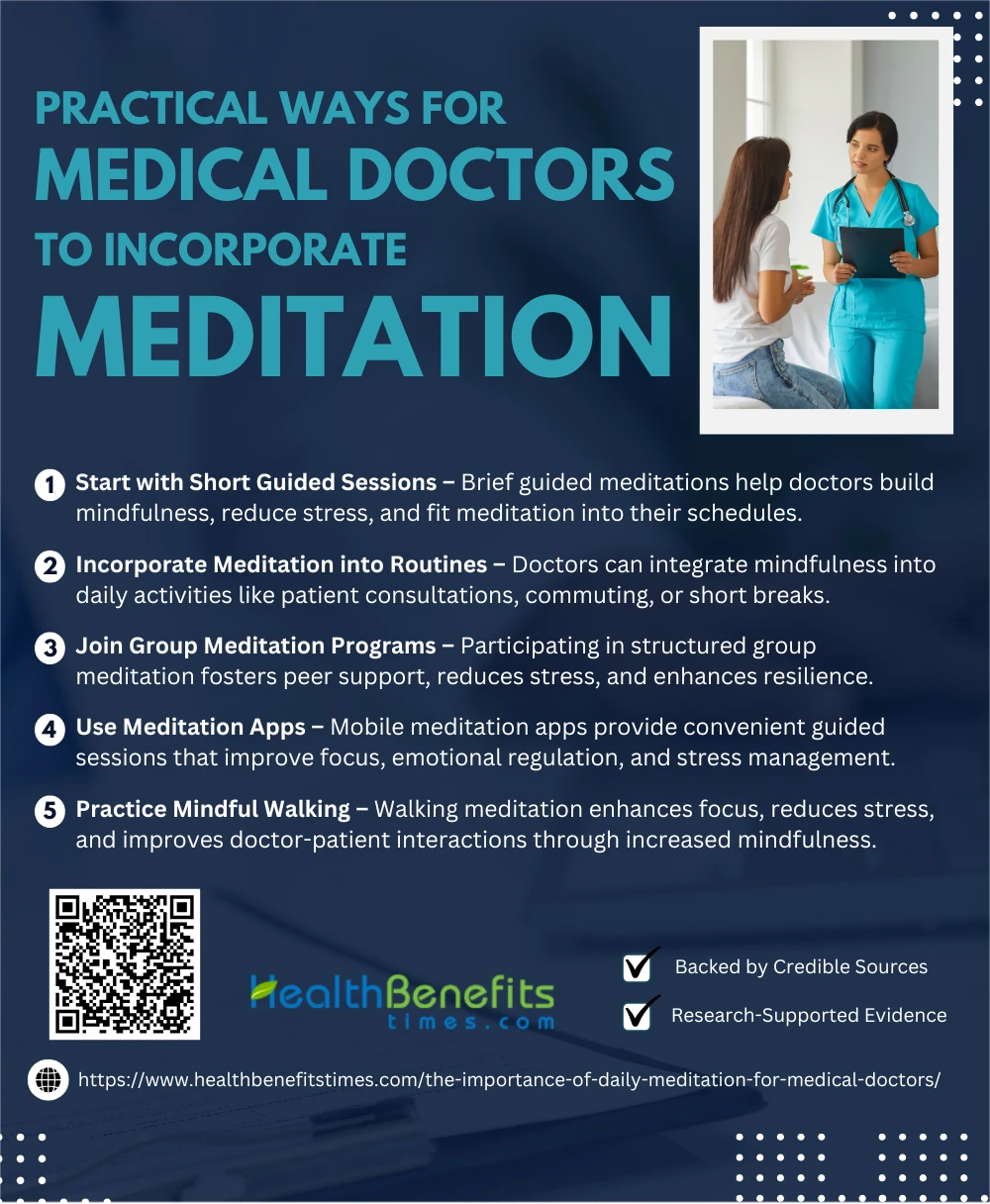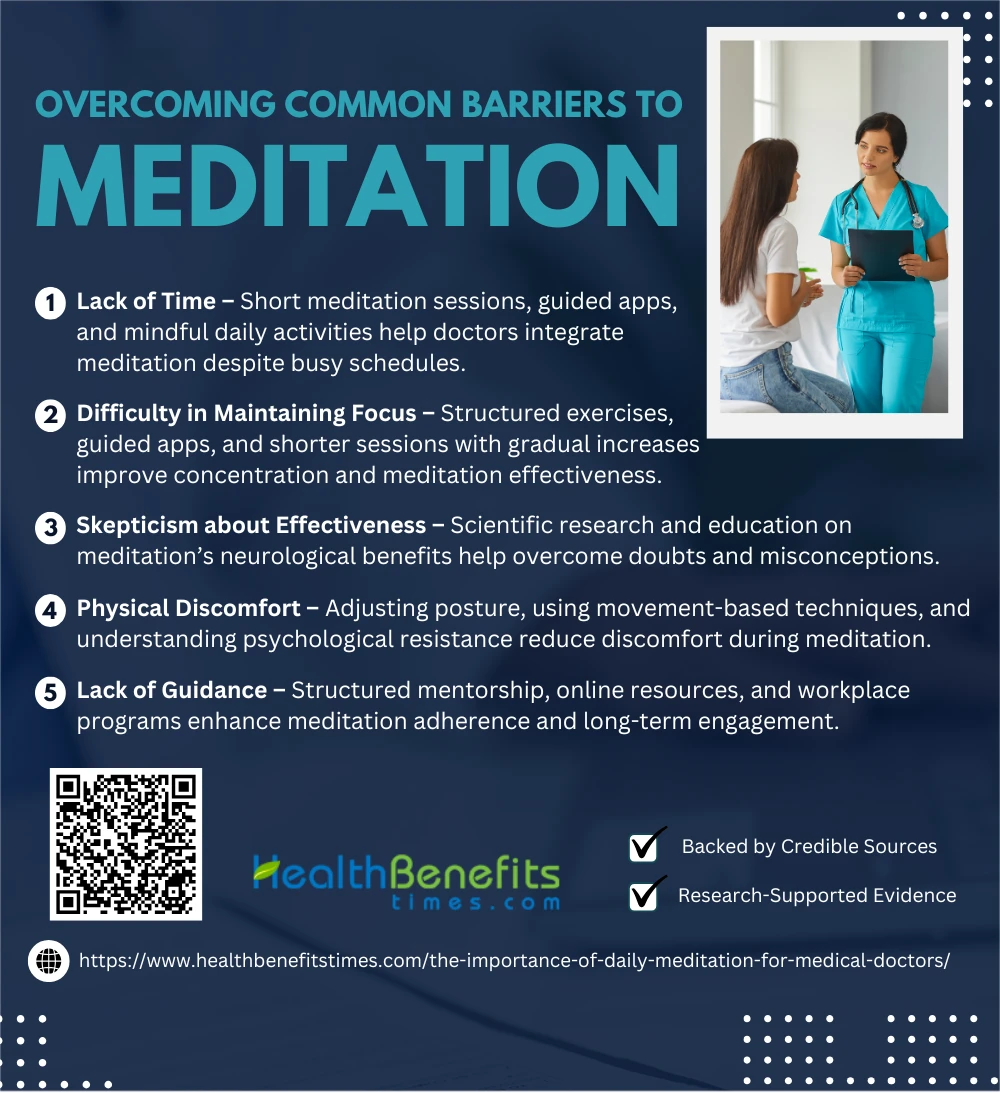- Daily meditation is a mindfulness practice that involves setting aside time each day to focus on relaxation, awareness, and mental clarity.
- Regular meditation helps medical doctors manage stress, prevent burnout, and improve emotional well-being, leading to better patient care.
- Daily meditation sharpens focus, enhances decision-making, and improves memory retention, essential skills for medical professionals handling high-pressure situations.
 Medical doctors are healthcare professionals trained to diagnose, treat, and prevent illnesses to improve patients’ well-being. ({% https://app.scholarai.io/paper?paper_id=DOI:10.3390/ijerph18084033 trusted %}) The demanding nature of their profession often leads to stress, burnout, and mental fatigue, making it essential to explore stress management techniques like daily meditation. Research indicates that mindfulness meditation significantly enhances doctors’ mental health, increasing mindfulness, empathy, and communication skills. ({% https://app.scholarai.io/paper?paper_id=DOI:10.3390/ijerph18084033 trusted %}) Furthermore, regular meditation improves sleep patterns among resident physicians, contributing to better cognitive function and patient care quality. ({% https://app.scholarai.io/paper?paper_id=DOI:10.1177/09727531211039070 trusted %}) Studies show that physicians engaging in mindfulness-based interventions experience reduced stress and burnout, leading to enhanced job satisfaction and overall well-being. (1) Meditation has also been linked to improved patient safety and reduced adverse events, emphasizing its role in medical practice. (2) Additionally, guided meditation programs for doctors have been shown to reduce stress levels and increase resilience against professional burnout. (3) Beyond stress management, meditation fosters emotional intelligence, which is crucial in doctor-patient interactions. (4) The benefits of meditation extend to holistic well-being, influencing doctors’ mental clarity and decision-making abilities. (5) As a result, incorporating daily meditation into medical professionals’ routines is a crucial step toward fostering a healthier, more balanced healthcare system. (6)
Medical doctors are healthcare professionals trained to diagnose, treat, and prevent illnesses to improve patients’ well-being. ({% https://app.scholarai.io/paper?paper_id=DOI:10.3390/ijerph18084033 trusted %}) The demanding nature of their profession often leads to stress, burnout, and mental fatigue, making it essential to explore stress management techniques like daily meditation. Research indicates that mindfulness meditation significantly enhances doctors’ mental health, increasing mindfulness, empathy, and communication skills. ({% https://app.scholarai.io/paper?paper_id=DOI:10.3390/ijerph18084033 trusted %}) Furthermore, regular meditation improves sleep patterns among resident physicians, contributing to better cognitive function and patient care quality. ({% https://app.scholarai.io/paper?paper_id=DOI:10.1177/09727531211039070 trusted %}) Studies show that physicians engaging in mindfulness-based interventions experience reduced stress and burnout, leading to enhanced job satisfaction and overall well-being. (1) Meditation has also been linked to improved patient safety and reduced adverse events, emphasizing its role in medical practice. (2) Additionally, guided meditation programs for doctors have been shown to reduce stress levels and increase resilience against professional burnout. (3) Beyond stress management, meditation fosters emotional intelligence, which is crucial in doctor-patient interactions. (4) The benefits of meditation extend to holistic well-being, influencing doctors’ mental clarity and decision-making abilities. (5) As a result, incorporating daily meditation into medical professionals’ routines is a crucial step toward fostering a healthier, more balanced healthcare system. (6)
The Challenges Faced by Medical Doctors
Medical doctors encounter numerous challenges, including high stress, excessive workload, and mental health struggles. Burnout is a significant issue, with many doctors experiencing emotional exhaustion and reduced job satisfaction. (7) Palliative care physicians also face emotional distress while treating terminally ill patients. (8) Junior doctors working during crises like COVID-19 reported extreme stress due to limited resources and overwhelming patient loads. (9) Rural doctors face additional difficulties in providing adequate healthcare services. (10) Leadership and engagement challenges further complicate doctors’ professional experiences, affecting healthcare systems worldwide. (11)
Science behind Meditation and Stress Reduction
Meditation plays a significant role in reducing stress by altering brain activity and regulating cortisol levels. Research shows that mindfulness-based stress reduction enhances emotional well-being by reducing stress-related neural activity. (12) Studies also reveal that long-term meditation practice improves psychological resilience and stress response. (13) Furthermore, meditation-induced relaxation fosters neuroplasticity and cognitive flexibility. (14) Kabat-Zinn’s mindfulness program has demonstrated significant benefits in stress modulation and mental clarity. (15) Additionally, meditation facilitates autonomic nervous system balance, improving overall physiological well-being. (16)
Key Benefits of Daily Meditation for Medical Doctors
Daily meditation helps medical doctors enhance focus, regulate emotions, and prevent burnout. It boosts mental clarity, emotional resilience, and physical health, ensuring better patient care while maintaining personal well-being and work-life balance.
1. Reduces Stress and Burnout
Daily meditation significantly reduces stress and prevents burnout among medical doctors by fostering emotional resilience and mental clarity. (1) It enhances emotional stability, reducing anxiety and exhaustion. (17) Meditation also improves cognitive function and decision-making, essential for patient care. (18) Additionally, it supports mindfulness, enhancing doctor-patient communication. (19) Long-term meditation even promotes physiological well-being, improving heart rate and blood pressure. (20)
2. Enhances Mindfulness and Focus
Daily meditation significantly enhances mindfulness and cognitive focus among medical doctors by improving attention span and emotional regulation. (21) Studies show that meditation strengthens cognitive function, improving memory and decision-making abilities. (22) Regular mindfulness practice also increases resilience, helping doctors stay present in high-pressure environments. (23) Meditation-based interventions have shown positive effects on doctors’ well-being, reducing mental fatigue. (24) Furthermore, meditation fosters deep concentration, allowing doctors to provide better patient care. (25)
3. Improves Doctor-Patient Communication
Daily meditation enhances doctor-patient communication by fostering mindfulness and empathy, leading to more meaningful interactions. (26) It reduces communication anxiety, helping doctors build patient trust. (27) Mindfulness-based interventions improve active listening and reduce defensive medical practices. (28) Meditation also strengthens the therapeutic presence, improving relational dynamics. (29) Additionally, compassion-based meditation enhances doctors’ ability to express care and emotional understanding. (30)
4. Enhances Emotional Well-being
Daily meditation significantly enhances emotional well-being among medical doctors by reducing stress and promoting psychological resilience. (31) Studies show that meditation fosters self-compassion and emotional balance, preventing burnout. (30) Regular mindfulness practice improves mood and overall mental health. (32) Meditation has been linked to increased positive emotions, supporting better doctor-patient interactions. (33) Additionally, meditation aids in emotional regulation, helping doctors navigate workplace challenges with greater ease. (34)
5. Boosts Overall Health and Immunity
Daily meditation enhances overall health and strengthens immunity by reducing stress and regulating immune responses. (35) Studies show that meditation positively affects immune function by increasing antibody production and reducing inflammation. (36) It also promotes relaxation, which lowers cortisol levels and improves cardiovascular health. (37) Mind-body therapies like meditation have been linked to improved immune responses. (38) Additionally, mindfulness practices contribute to cellular health by modulating stress-related gene expression. (39)
Practical Ways for Medical Doctors to Incorporate Meditation
Medical doctors can integrate meditation into their busy schedules with short, practical techniques. Simple practices like mindfulness, breath work, or guided sessions can enhance focus, reduce stress, and improve overall well-being.
1. Start with Short Guided Sessions
Medical doctors can begin incorporating meditation by engaging in short, guided sessions, which help build mindfulness and reduce stress. (40) Research suggests that brief relaxation exercises lead to immediate reductions in anxiety and mental fatigue. (41) Medical schools have integrated mindfulness-based programs, encouraging doctors to engage in short, structured meditation sessions. (23) Guided meditation can also be personalized, allowing doctors to explore techniques that best suit their work schedules. (42)
2. Incorporate Meditation into Routines
Medical doctors can seamlessly integrate meditation into daily routines by practicing mindfulness during patient consultations or while commuting. (43) Studies suggest that structured meditation breaks enhance cognitive function and emotional well-being. (44) Short breathing exercises between patient visits can improve focus and reduce stress. (45) Additionally, scheduling a few minutes of meditation before or after shifts fosters long-term resilience against burnout. (46)
3. Join Group Meditation Programs
Participating in group meditation programs provides medical doctors with structured mindfulness training and peer support, reducing stress and burnout. (23) Studies show that meditation in professional groups enhances emotional well-being and resilience. (47) Programs like Mindfulness-Based Stress Reduction (MBSR) have demonstrated effectiveness in medical settings, improving mental clarity and decision-making. (48) Engaging in guided meditation sessions fosters a sense of community, encouraging long-term practice and sustained benefits. (49)
4. Use Meditation Apps
Medical doctors can incorporate meditation into their daily routines using mobile apps that offer guided sessions, improving mindfulness and stress management. (50) Research shows that mindfulness-based apps enhance focus and emotional regulation in medical professionals. (51) Using meditation apps has been linked to improved brain function and self-awareness among healthcare workers. (52) Additionally, app-based meditation reduces workplace stress and increases overall well-being in physicians. (53)
5. Practice Mindful Walking
Medical doctors can integrate mindfulness into their daily routines by practicing mindful walking, which enhances focus and emotional well-being. (54) Research suggests that mindful walking reduces stress and improves patient interactions by fostering attentiveness. (55) Walking meditation allows doctors to cultivate self-awareness and resilience against burnout. (56) Additionally, mindful walking has been linked to increased compassion and improved doctor-patient communication. (57)
Overcoming Common Barriers to Meditation
Many doctors struggle with meditation due to time constraints, skepticism, or unfamiliarity. Overcoming these barriers through flexible techniques, mindset shifts, and practical strategies can make meditation a sustainable, beneficial habit.
1. Lack of Time
One of the most common barriers to meditation is the perceived lack of time. Research suggests that even short meditation sessions can provide significant benefits, helping individuals integrate mindfulness into their busy schedules. (58) Implementing brief mindfulness techniques, such as deep breathing or body scan exercises, can make meditation more accessible without requiring large time commitments. (59) Studies also indicate that guided meditation apps help individuals fit mindfulness into their daily routines by offering short, structured sessions. (60) Additionally, practicing mindfulness while performing daily activities, such as walking or commuting, can effectively integrate meditation into a hectic lifestyle. (61)
2. Difficulty in Maintaining Focus
Many individuals struggle with maintaining focus during meditation, leading to frustration and discontinuation of practice. Research suggests that structured mindfulness exercises, such as breath awareness and body scans, can improve concentration and enhance meditation effectiveness. (61) Cognitive distractions and wandering thoughts can be managed by using guided meditation apps, which provide verbal cues to refocus attention. (60) Meditation techniques that incorporate visualizations and mantra repetition have also been shown to increase sustained attention and reduce mind-wandering. (62) Additionally, practicing shorter meditation sessions with gradual increases in duration can help build focus and prevent frustration. (68)
3. Skepticism about Effectiveness
Skepticism toward meditation often stems from misconceptions about its effectiveness, yet empirical research has demonstrated its benefits. Studies highlight that mindfulness meditation can significantly reduce stress and improve cognitive function. (49) Additionally, integrating meditation with physical activity has been found to enhance mental health, despite initial doubts. (64) Overcoming skepticism requires structured education on the neurological effects of meditation, which has shown to improve emotional resilience and reduce anxiety. (65)
4. Physical Discomfort
Physical discomfort is a common barrier to meditation, yet research shows that proper posture adjustments and movement-based practices can mitigate this issue. Studies indicate that addressing discomfort through body-awareness techniques enhances meditation adherence. (58) Additionally, incorporating walking meditation or mindful stretching can help alleviate physical strain. (49) Understanding the psychological factors behind discomfort also plays a crucial role in overcoming resistance. (66)
5. Lack of Guidance
Lack of guidance is a significant obstacle to meditation, often leading to frustration and abandonment of practice. Research suggests that structured instruction and mentorship greatly enhance meditation adherence. (58) Online resources and guided programs have also proven effective in bridging the guidance gap. (68) Studies highlight that personalized coaching and meditation communities significantly reduce dropout rates. (49) Additionally, integrating meditation into educational and workplace settings fosters long-term engagement. (67)
Challenges and Misconceptions about Meditation in Medicine
Despite its proven benefits, meditation in medicine faces skepticism, time constraints, and misconceptions. Many doctors view it as impractical or unscientific, yet simple, evidence-based techniques can seamlessly fit into medical practice.
1. Misconception: Meditation is a Religious or Spiritual Practice
One of the most common misunderstandings about meditation is that it is inherently religious. Many medical professionals perceive it as a spiritual or mystical practice, often associated with Buddhism, Hinduism, or New Age philosophies. However, research highlights that meditation, particularly mindfulness-based interventions (MBIs), is secular, scientifically backed, and can be used as a therapeutic tool without any religious connotations. For instance, mindfulness-based stress reduction (MBSR) and mindfulness-based cognitive therapy (MBCT) have been successfully incorporated into medical and psychological treatments.
2. Challenge: Lack of Formal Training in Medical Curricula
Despite overwhelming evidence supporting the benefits of meditation in healthcare, it is rarely included in medical training programs. Many physicians do not receive formal education on how to practice or prescribe meditation as a complementary therapy. Without structured training, they may feel unqualified to recommend it to patients, resulting in limited adoption within clinical practice.
3. Misconception: Meditation Lacks Scientific Validation
A persistent myth among healthcare professionals is that meditation lacks rigorous scientific support. However, numerous randomized controlled trials (RCTs) and neuroscientific studies have demonstrated its efficacy in reducing stress, improving mental health, and enhancing overall well-being. Brain imaging studies show that meditation enhances neuroplasticity, alters brain structure, and regulates the autonomic nervous system.
4. Challenge: Time Constraints for Busy Healthcare Providers
Doctors and medical staff often cite time constraints as a significant barrier to practicing meditation. The misconception that meditation requires long, uninterrupted sessions prevents many from integrating it into their daily routines. However, studies show that even five-minute mindfulness exercises can improve focus, reduce stress, and enhance decision-making in high-pressure environments.
5. Misconception: Meditation Is Only for Mental Health, Not Physical Health
While meditation is often associated with stress relief and emotional well-being, its benefits extend to physical health conditions such as chronic pain management, hypertension, cardiovascular health, and immune system regulation. Clinical trials have shown that meditation can lower blood pressure, decrease inflammatory markers, and reduce pain perception in patients with fibromyalgia and arthritis.
6. Challenge: Resistance Due to Perceived Cultural Barriers
Another challenge is the perception that meditation is culturally specific and not universally applicable. Some healthcare providers and patients from non-Eastern backgrounds may resist meditation due to its historical association with Asian spiritual traditions. However, mindfulness practices have been successfully adapted into Western medicine, including in military training, corporate wellness programs, and psychotherapy.
7. Misconception: Meditation Is a Passive or Ineffective Treatment
Some critics argue that meditation is merely a passive relaxation technique rather than an active therapeutic tool. However, research demonstrates that meditation actively reshapes brain function by enhancing areas involved in emotional regulation, focus, and resilience. Long-term meditators exhibit increased grey matter density in the prefrontal cortex, which is associated with improved cognitive control and emotional stability.
8. Challenge: Difficulty in Measuring Outcomes and Compliance
Unlike pharmaceuticals, which have clear dosage guidelines and measurable biomarkers, meditation’s effects can be difficult to quantify in a clinical setting. Compliance is also a challenge, as patients may struggle with consistency, similar to adherence issues with exercise or diet changes. Healthcare institutions need to develop standardized protocols for integrating meditation into treatment plans.
9. Misconception: Meditation Can Replace Medical Treatment
While meditation is a powerful complementary therapy, it is not a replacement for conventional medical treatments. Some proponents falsely claim that meditation alone can cure diseases such as cancer, leading to unrealistic expectations. Physicians must emphasize that meditation should be used alongside medical interventions, not as a substitute.
10. Challenge: Patient Skepticism and Low Adherence
Many patients remain skeptical about meditation’s effectiveness or struggle to integrate it into their routines. To improve adherence, medical professionals must provide structured guidance, resources, and follow-up support. Group-based meditation programs, mobile apps, and workplace mindfulness initiatives have been shown to improve long-term engagement.
Conclusion
Daily meditation is a powerful tool that helps medical doctors manage stress, enhance focus, and prevent burnout while improving overall well-being. By integrating even short mindfulness practices into their routines, doctors can cultivate mental clarity, emotional resilience, and better patient care. Overcoming misconceptions and time constraints is key to making meditation a sustainable habit. Prioritizing self-care through meditation not only benefits doctors but also creates a healthier, more compassionate healthcare environment.




